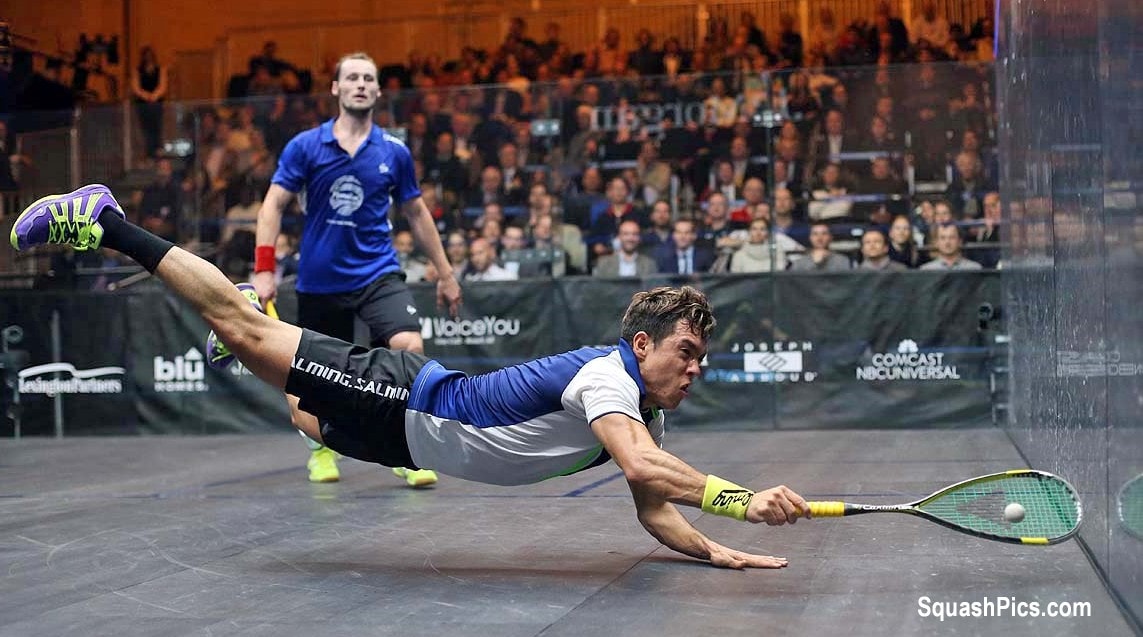When you play someone who is at a similar or higher standard of ability and fitness to you, you will often spend much of the match in oxygen debt.
What is oxygen debt?
Oxygen debt occurs when your body isn’t able to get sufficient oxygen around the body quickly enough. The main symptom of oxygen debt is heavy and quick breathing, and unfortunately in squash you don’t get much time to let your breathing calm down. Soon after a tough rally is finished, the next one begins.
How will it affect the match?
You’ll never quite become comfortable physically in a tough match, which means a lot of the game becomes about who can cope with their oxygen debt the best. This is especially important the better a player you become and at a high club or county level. At this level, the match can often become a question of who can maintain their skillset, shape, technique and shot selection best under the pressure. Naturally, a big part of playing at a high level is learning how to handle and adapt to being in oxygen debt.
Recognising when you need to change your game
It sounds obvious that everyone should know when they are tired, but quite often players will go into oxygen debt on auto-pilot, and start playing sloppily without really knowing it. They’ll instinctively be tempted to start going for ultra-attacking shots and try to cut rallies off early, which can be effective if you are still able to move your feet sufficiently to get into a good position. Quite often though, positional play becomes really sloppy when you are tired and so forcing an attacking shot isn’t a good idea. More subtle signs of oxygen debt include your length often starts bouncing shorter, which will create other problems if you are unable to get the T-Position back and giving your opponent a chance to attack.
Signs you have become affected by oxygen debt include:
- Not recovering to the T-Position, or not recovering the T quickly enough
- Length shots bouncing short
- Trying to win the rally really quickly
- Attempting to play spectacular shots that aren’t really an option
- Slow recovery between rallies
- Sustained heavy breathing
- Hitting the ball out more than normal
- Shots losing accuracy
Some of these are very obvious, but you must act the moment you notice one of these things, or any other symptom of tiredness, affecting your game.
How to adapt – using the height of the court
- Mentally re-focus, and remind yourself what you want to achieve:
- Hitting length higher and slower
- Attacking earlier in the rally, but still not forcing attacking shots
The first thing is to stay calm, which can take a bit of doing, and avoid trying to win rallies immediately. After that, it’s important you focus on your length shots, as accurate length which gets your opponent behind you will help you to handle a lot of the problems that oxygen debt brings.
Start by aiming a bit higher on the front wall with your length – hit slower drives and go for more lob shots – as this will help you still get your length shots to the back of the court, but also give you a bit more time to recover to the T-Position. This deals with two of the major problems of oxygen debt. If you are managing to get the ball to the back of the court with high slow shots, and therefore get your opponent behind you, you will also typically get more opportunities to attack and intercept their shots, which means you don’t need to force attacks and take big risks in the pursuit of winning rallies.
When you are tired, you can and should try to win rallies when the opportunity arises. Trying to play lots of winners can be a very good strategy when it works, but it is high risk when you’re tired and not moving your feet well. The key to getting the right balance with winning shots is to attack earlier in the rally where possible, but not to force opportunities. Try to ensure that you are going for the majority of these winning shots once you have moved your opponent behind you – ideally with your high, slow lob – as you would in the majority of the match. The aim is to try and take the first or second opportunity you get, perhaps a loose length shot from your opponent that you can volley, rather than being more patient and waiting to see if you can create a better opportunity. You need to stop trying to keep moving your opponent and instead focus on being clinical as soon as a chance presents itself. This doesn’t mean forcing a winning shot, as it might take dozens of shots for you to get an opportunity, but don’t pass that opportunity up when it does come, be it the fourth or fiftieth shot of the rally.
Start by recognising you are in oxygen debt, stay calm, aim to get the ball to the back of the court in any which way, and then go from there. Let us know how it goes below!


Leave a Reply